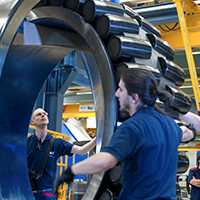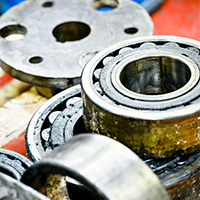
How do you choose
the right bearing?
Choosing the right type of bearing during the design stage is crucial to ensure that your machine works safely, consistently and efficiently. It is therefore important to consider all operational parameters, such as the dimensions, rotational speed, load, material, lubrication/seals and the desired service life, when choosing the correct bearing.
Different types of bearings
When choosing the right bearing, it is important to consider that every type of bearing has specific properties, depending on
its design, which make it more or less suitable for certain applications.
Deep-groove ball bearings, for example, can withstand
both radial and axial loads. They cause little friction, can be produced with high precision and can provide near-noiseless
performance. They are therefore preferred for use in small and medium-sized electric motors.
Spherical bearings can withstand very heavy loads and can adapt to various
applications, making them particularly suitable for use in heavy industry, where heavy loads can lead to deformations and
misalignments.
However, in many instances, a number of factors must be taken into account and weighed up against each other when choosing the right type of bearing. The most important issues to consider when choosing a bearing type are:
- Space available
- Loads
- Misalignment
- Precision
- Rotational speed
- Bearing noise
- Rigidity
- Axial displacement capability
- Installation and removal
- Integrated seals
Factors also exist that do not relate to the bearing design. For example, the rigidity of an installation with angular contact ball bearings or tapered roller bearings also depends on the chosen preload. Moreover, the permissible rotational speed of a bearing is influenced by the precision of the bearing and the bearing cage design, and it is important to consider that the total cost and availability of a bearing installation can also affect the final choice.
Lubricants
Lubricants play an important role when it comes to bearings. Lubricants reduce friction, in turn reducing wear and increasing the service life of the bearing. Choosing a suitable lubricant is therefore just as important as choosing the right bearing. There is a specific lubricant and applicator for every application. Thanks to our extensive multi-specialist product range, the most suitable lubricant can be selected for specialist applications. Many decisions can also be simplified by opting for a universally applicable lubricant with a wide range of application options.
Available resources
To help you choose the right bearing and lubricants, all resources are available in hard copy or digital format, both online and offline. Modern calculation tools and documentation are available to support our application engineers when choosing bearing types. The calculation software allows application engineers to model and calculate all bearings, complex axes, shaft systems and complete power transmission systems. Construction data can be imported directly into your own CAD system by working with our suppliers, who have a large database containing 2D drawings and 3D models.
If you would like more information to help you choose the right bearing, get in touch with one of our specialists.
LEARN MORE ABOUT BEARINGS





